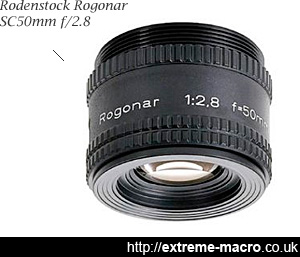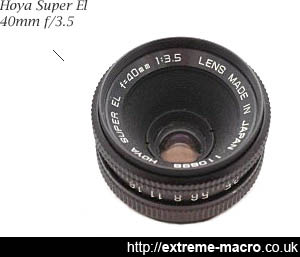Reject Enlarger Lenses
by Johan J Ingles-Le Nobel
Last updated August 31, 2017
There are lenses that are good for extreme macro, but there are far more lenses that are not so good.
The thing that all the poor performers have in common is that they do not have a 6 element achromatic construction. The best ones do.
The thing that all the poor performers have in common is that they do not have a 6 element achromatic construction. The best ones do.Spotting A Good Enlarger Lens
The makers of enlarger lenses often issue various ranges of enlarger lenses, with a budget line through to a top line. The top line delivers the best quality, has the best optical correction, and usually has 6 elements in 2 groups of 3.
Nikon El-Nikkor 50mm f/4

The Rodenstock Rogonar is a budget line 4-element lens, not as good as the premium 6-element Rodenstock Rodagon line, or 6 element enlarger lenses from other manufacturers.
Its bigger and better brother the El-Nikkor 50mm f/2.8 is splendid enlarger lens for use with extreme macro, but the El-Nikkor 50mmmm f/4 is not. The f/4 was the budget version of the f/2.8, and was made with 4 elements in 2 groups.
On it's own the f/4 isn't completely terrible, it's just that there are plenty of 2.8s around at decent prices as enlargers aren't used nearly as much as they used to be.
Hoya Super El 40mm f/3.5
I bought the Hoya Super El 40mm f/3.5 as a stop gap measure to act between the 50mm El-Nikkor and the 28mm Componon. Hoya is not one of the high quality lens makers. Allegedly the Hoya Super El 40mm f/3.5 is also sold as the Bogen 40mm f/3.5 WA, which has a good reputation for enlargement use, but as a reverse macro lens Hoya Super El 40mm f/3.5 was about as bad as it gets.
Using A Poor Enlarger Lens
Although the accepted wisdom is not to use these 4 element lenses for extreme macro, if it's a choice between having a stab at extreme macro with a poorer lens or waiting for the perfect lens to show up, don't hesitate to use the poorer lens.
It takes considerable experience before the better lenses come into their own and besides, 'bad' and 'reject' are a bit of a relative concept as the difference can be seen only at the pixel level.
And, in all honesty, it's not usually going to be the quality of the lens that lets your down when you start learning this stuff, it's usually the quality of the light where most of the issues occur initially. Until you've mastered that to a certain degree, lens barely matters, good or bad.
Better to have loved and lost than never to have loved at all.

Hoya Super El 40mm f/3.5. a budget 4 element design, it is somewhat useless for extreme macro stacking, but certainly makes a fetching old school paperweight.
Rodenstock Rogonar-SC 50mm f/2.8
A lens that was gifted me by a friend in the US, the Rodenstock Rogonar is a budget line 4-element lens, not as good as the premium 6-element Rodenstock Rodagon line, or 6 element enlarger lenses from other manufacturers. There is surprisingly little detail available about the Rogonar "SC" series. - It was designed for use with a special filter between the elements - effect filters are to put into a gap, which is between two lens groups.
Related Articles





